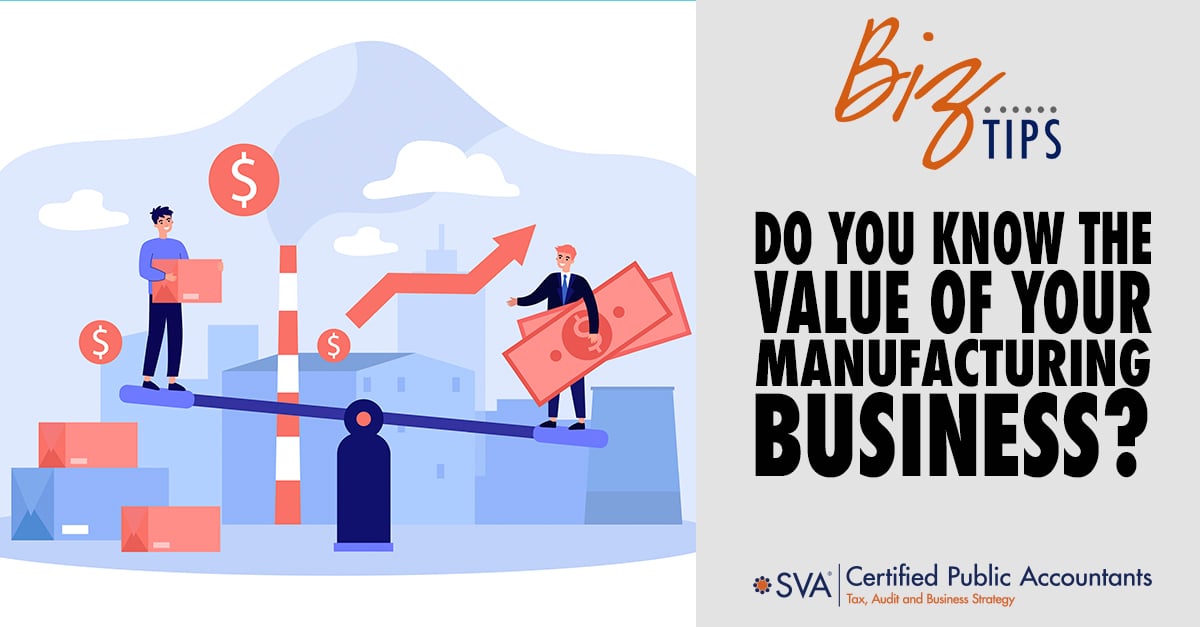Owners of manufacturing businesses often wonder, “What is my business worth?”
This question is especially pressing if the business is the target of an acquisition or if the owner is considering selling or transferring the business to heirs. Valuing your manufacturing business is a critical measure for you and your stakeholders who may include family members, shareholders, your management team, employees, and lenders.
Even if ownership changes are not immediately imminent, knowing the value of your manufacturing company is an important metric to help you make current business decisions and plan effectively for whatever may come (e.g., an unexpected business interruption, an unsolicited offer to buy, or taking the next step in your exit plan.)
Ways to Define Your Company’s Value
Business valuation determines the economic worth of your manufacturing company. There are three common methods used to define the value of a business:
| Fair Market Value |
is the theoretical price that a willing buyer would pay to a willing seller. It is a price independent of any related party interests and without any known outside influence. |
| Investment Value |
considers the value of your company based on a specific buyer’s investment expectations or requirements. The buyer may have a defined strategy or purpose for buying the company that could impact the valuation. |
| Liquidation Value |
is the value of your company if assets were sold off and liabilities were settled immediately. It operates under the assumption that the assets of the business are worth more when sold piecemeal rather than as an operating entity. |
The Importance of Net Working Capital
Net working capital is the “grease” that keeps your business running. A manufacturing company’s net working capital is critical to any type of valuation because it allows the business to continue operating from the first day of new ownership.
The components of net working capital include accounts receivable that provide for future cash flow, on-hand inventory to execute sales orders, and the plant, equipment, and property to operate and turn inventory into salable products.
All stakeholders and buyers will be interested in the net working capital of the business at a given time. You should monitor net working capital as part of your monthly or quarterly financial review process so you have an ongoing picture of the value of your business beyond just the balance sheet, income statement, and cash flows.

Four Ways to Approach Valuations
Valuation experts generally use one of four approaches to value manufacturing businesses. These are:
- The Discounted Cash Flow (DCF) approach is often the preferred method because the valuation is based on estimated future operating results of the company, rather than historical results. DCF does not rely on comparisons to other companies. The estimates include various assumptions such as projected revenues, industry growth, and discount rates. DCF places less emphasis on the balance sheet and more emphasis on earnings, where the multiple can be based on the buyer’s required rate of return combined with the business’s growth potential.
- Comparable Transaction Analysis is an “apples-to-apples” approach where a general valuation is determined based on a recent transaction involving a similar company in a similar industry. It involves conducting research on similar and recently sold companies (also on the market) and applying the data to the manufacturing business undervaluation. It is rare, however, to be able to identify companies that truly are apples-to-apples, so the precision of a “comp” valuation might not be as reliable. However, attributes of comparable transactions can be informative and help build a case for your transaction.
- Asset-Based Valuation focuses on the net asset value of a company. It uses a balance sheet-driven approach, subtracting the liabilities from the assets to arrive at a number that can support a factor to the fair market valuation of the company. Valuation adjustments would be made from book value to fair market value such as factors for property, equipment, or inventory that has been depreciated at a value on which a willing buyer and willing seller would agree.
- The Industry Rules of Thumb Approach is the “back of the napkin” method of valuation in which a multiple is expected by industry and applied to adjusted earnings before interest, taxes, depreciation, and amortization (EBITDA) to arrive at an enterprise value. This market-based approach usually provides a quick answer and a general assumption for a valuation range, but it does not account for specific qualitative information about the business under valuation.
(Download Video Transcript)
Get Started With a Valuation Analysis
The first step in determining the value of your manufacturing business is to perform a valuation analysis. You can do so internally or work with an external advisor such as a financial planner, CPA, or exit planning specialist. A valuation analysis will provide a clear picture of where your company stands and improve your understanding of its strengths and challenges.
With a base valuation in hand, you can define your value gap which is the difference between your company’s current valuation and the valuation you would like to reach. This will help you more effectively set goals and objectives for your business so you can move forward on a transition or successful exit strategy.

© 2021 CPA ContentPlus

